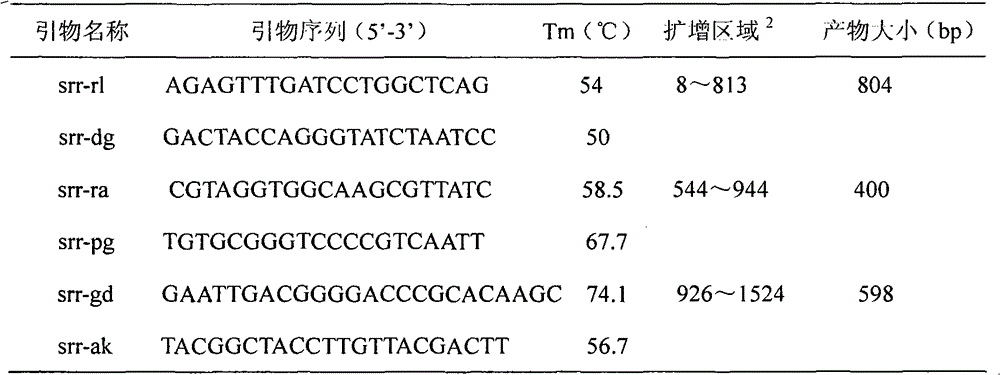Gene chip for detecting common clinical pathogenic microorganism
A pathogenic microorganism and gene chip technology, which is applied in the field of gene chips for the detection of common clinical pathogenic microorganisms, can solve the problems of staying, unable to fully meet the needs of accurate detection of microorganisms, and a single probe, and achieves moderate length, reasonable probe design, high specific effect
- Summary
- Abstract
- Description
- Claims
- Application Information
AI Technical Summary
Problems solved by technology
Method used
Image
Examples
Embodiment 1
[0062] The preparation of embodiment 1 gene chip
[0063] This example uses a nylon membrane as a solid phase carrier to illustrate the preparation method of the gene chip of the present invention.
[0064] (1) With a positively charged nylon membrane as a carrier:
[0065] Prepare a positively charged nylon membrane in a size of 4 x 2 cm 2 Size, placed in a dry environment at room temperature, ready for use.
[0066] (2) Design primers and probes:
[0067] Firstly, the 16S rRNA gene and ITS gene sequences of Staphylococcus aureus, Klebsiella pneumoniae, Pseudomonas aeruginosa, Candida albicans, Candida glabrata and Candida tropicalis were retrieved from the PUBMED online database by DNAMAN 5.2.2 (Lynnon Biosoft, USA) and NCBI BLAST software (http: / / www.ncbi.nlm.nih.gov / BLAST / ) are compared to find their conserved regions and hypervariable regions, and then apply Primer Premier 5.0 (PREMIER Biosoft International, CA) designed primers in these conserved regions and probes...
Embodiment 2
[0085] The detection of embodiment 2 pathogenic microorganisms
[0086] (1) Extract bacterial DNA
[0087] Staphylococcus aureus (ATCC25923), Klebsiella pneumoniae (ATCC700603), Pseudomonas aeruginosa (ATCC27853), Candida albicans (ATCC64548), and Candida glabrata (ATCC900030) were extracted by CTAB / NaCl method, respectively. and the pathogenic microorganism DNA of Candida tropicalis (CCTCC AY 92045) as templates.
[0088] (2) target DNA amplification
[0089] The 4 pairs of primers in Tables 1 and 2 were used for PCR reaction to amplify the target DNA. The multiplex PCR reaction solution consists of 10×buffer (Biostar), each primer of 10 μmol / L, 10mmol / L dNTPs (Roche), 2U Taq DNA polymerase (Biostar), Biotin-11-dUTP (Fermentas) and sterile water composition. The PCR reaction conditions are: 50μl system (multiple PCR):
[0090] Taq buffer (10×) 5μl
[0091] dNTPs (10mM) 0.8μl
[0092] srr-rl 1.5 μl
[0093] srr-dg 1.5 μl
[0094] srr-ra 1.5 μl
[0095] srr-pg 1.5μl...
Embodiment 3
[0122] The detection of embodiment 3 pathogenic microorganisms
[0123] In this example, according to the method of Example 2, 6 strains were cultured and biochemically identified as Staphylococcus aureus, Klebsiella pneumoniae, Pseudomonas aeruginosa, Candida albicans, Candida tropicalis and Candida glabrata The pathogenic microorganisms were detected by clinical isolation (Department of Laboratory, Zhongnan Hospital, Wuhan University, Wuhan, Hubei). The results showed that the detection results were completely consistent with the results of culture and biochemical identification.
PUM
 Login to View More
Login to View More Abstract
Description
Claims
Application Information
 Login to View More
Login to View More - R&D
- Intellectual Property
- Life Sciences
- Materials
- Tech Scout
- Unparalleled Data Quality
- Higher Quality Content
- 60% Fewer Hallucinations
Browse by: Latest US Patents, China's latest patents, Technical Efficacy Thesaurus, Application Domain, Technology Topic, Popular Technical Reports.
© 2025 PatSnap. All rights reserved.Legal|Privacy policy|Modern Slavery Act Transparency Statement|Sitemap|About US| Contact US: help@patsnap.com



